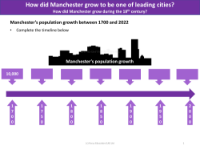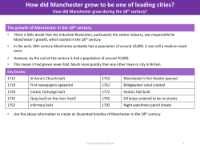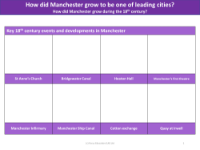How did Manchester grow during the 18th Century? - Teacher notes

History Resource Description
During the 18th century, Manchester transitioned from a medium-sized town into a bustling urban centre, largely due to the advent of the Industrial Revolution. At the beginning of the century, the population was estimated to be around 10,000, but by the century's end, it had skyrocketed to approximately 70,000. This period of rapid growth was marked by Manchester's emergence as a hub for textile production, specialising in materials such as wool, cotton, linen, and silk. The establishment of a cotton exchange in 1729 facilitated the trade of cotton and was indicative of the city's burgeoning industry.
Infrastructure and public services in Manchester also saw significant advancements throughout the 18th century. St Ann's Church was constructed in 1712, followed by the launch of Manchester's first newspaper in 1719. The city's connectivity improved with the creation of a quay on the River Irwell in 1735 and the construction of the Bridgewater Canal in 1761, improving coal transportation. Social amenities developed as well, with the introduction of an infirmary in 1752, Manchester's first theatre in 1753, and the construction of Heaton Hall in 1772. By 1792, efforts to urbanise the city further were evident with the introduction of street cleaning and lighting with oil lamps, as well as the presence of night watchmen, although their efficacy was questionable. These developments collectively contributed to Manchester's evolution into a leading city during the 18th century.





